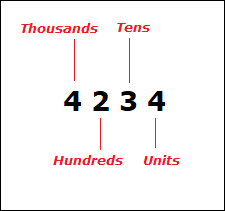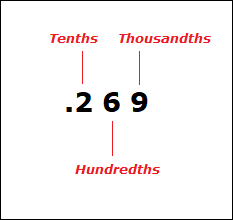Places after Decimal Point
Infinite, Terminating, Repeating Decimals
Large and Small Decimals
This section will look to give a good introduction to decimal numbers and decimal number place value.
So that we know what the digits after a decimal point in a decimal number represent.
Decimal numbers can contain one or more digits to the right of the decimal point.
Digits after Decimal Point
We can look at the numbers: 4.702 3.164 8.7745
The digits we see on the right of the decimal point each have their own decimal number place value.
The same way how the digits before the decimal point to the left have a place value.
For an example consider the following decimal number, 4234.269.
The whole number part to the left of the point is 4234, with each separate digit having its own place value.
When we move a place to the left, the digit gets 10 times larger than the previous place.

Now moving to the right of the decimal point follows a similar pattern.
However this time, each next place as we move to the right, gets 10 times smaller than the previous one.

The number system we most commonly use today is called the “Base 10 System”.
For those interested, more can be seen about this system at the splashlearn website.
Decimals, Infinite, Terminating, Repeating
In Math decimal numbers can be classed as “infinite” or “terminating”.
An infinite decimal is one that expands on and on after the decimal point to the right with no ending place.
A terminating decimal will have an ending to the digits on the right at some place.
Infinite & Infinite Repeating Decimal:
A decimal number could possible have no ending place after the decimal point, making it an “infinite decimal”.
There exist irrational numbers such as π and √8, that don’t have an end to their decimal form.
As an alternative to writing some of the decimal expansion out, it’s easier to just write π or √8 instead.
Terminating Decimal:
Decimal numbers such as 2.408 and 6.38 for example, are “terminating” decimals.
Which simply means that are decimals that indeed do have an end place somewhere to the right of the decimal point.
Decimal Number Place Value,
Smaller and Larger Decimal Numbers
It’s not uncommon with people first learning about decimal number place value to possibly think that decimal numbers such as:
4.6 and 4.06, are the same, but they aren’t.
4.6 is in fact the same as 4.60, though the zero is usually not written as we don’t really need it.
4.6 = 4.60 = 4.600 = 4.6000…. and so on.
So in the same way that 20 is greater than 2.
4.60 or 4.6 is greater than 4.06, we just need to pay attention the place value of the numbers after the decimal point.
- Home ›
- Fractions & Decimals › Decimal Numbers